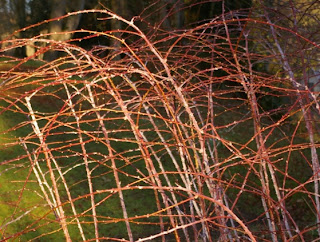 |
| Trafalgar Square at first light: the Keep out of London countdown clock at right. |
 |
| Head and tail of the queue, c. 7.30 am. |
Yesterday we went up to London to see the amazing exhibition
Leonardo da Vinci, Painter at the Court of Milan at the National Gallery. Although long flagged-up as something not to be missed, we failed to book tickets (it was sold out by the time it opened) and thus had to queue for the daily allocation. Taking no chances, we drove into London allowing Adrian to be in place by 5.30 - but even then he was fifth in the queue. I went to park in the suburbs and returned by tube. The queue grew and grew and hopefuls kept coming until we got inside at 10 am, though we learnt later that nobody who had arrived after about 7 am got in.
The exhibition has brought together half of Leonardo's known paintings, all of them done, or started, while he was working in Milan between 1482-99, together with sketches by him, and a supporting cast of work by his contemporaries and pupils. These show not only his influence, but also that he was indeed the master. It is a unique gathering of remarkable pieces, of which the star is perhaps the radiant
Portrait of Cecilia Gallerani, widely known as
The Lady with an Ermine, borrowed from Cracow, and there is the chance to see the newly accredited
Christ as Salvator Mundi, though damage has caused this to lose its lustre. It's also nice to be able to see Giampetrino's copy of
The Last Supper at eye level, rather than 'skied' on the wall of the antechapel at Magdalen.
 |
| Detail from The Lady with an Ermine |
This is an exhibition of Leonardo's works as a painter, and one has to put aside all thoughts of him in his various other guises; the architect and inventor appear only from doodles on the sketches, and there are none of the exquisite botanical drawings that place him still among the great botanical artists. In fact one has to look quite hard for any images of plants, and when found they are quite surprising. In the largest room of the exhibition two versions of The Virgin of the Rocks altarpiece face each other, brought together under one roof for the first time. The story of how they came about is complicated - see the catalogue - but the older one is the Louvre, and the younger, perhaps by about 15 years, is in the National Gallery's permanent collection. At first glance they look rather similar - a group of holy figures in a fantastic rocky landscape, but there are subtle differences in the imagery of the figures and their settings, and to me there is a surprising - if not shocking - difference in the plants in the landscape. In the French painting the plants are beautifully rendered, with the detail one expects from the great botanical artist that Leonardo was: an Iris, Polemonium and Aquilegia are clearly recognisable. Replacing the Iris in the London version is a clump of apparent Narcissus tazetta - but it is no normal daffodil. The flowers are good enough, but they arise on bracteose scapes, from a clump of plantain-like leaves. Next to this are two completely fantastical plants that cannot be identified, and there are other oddities elsewhere in the landscape. It seems that here Leonardo, the inveterate doodler and inventor, has invented his own flowers for Paradise, and in the evolution of the painting has translated the scene from an earthly to a heavenly location. It is nice to think that he envisaged daffodils there.
 |
| Detail of fantastic plants in the London version of The Virgin of the Rocks. |


































